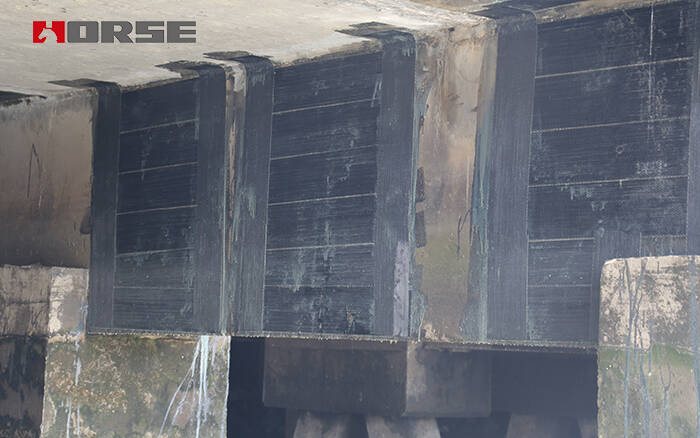Solutions
Horse Construction offers full range of structural strengthening materials with technical supports, documentation supports, products supports, project supports.
unidirectional carbon fiber sheet

Principles of strengthening bridge structures with carbon fiber sheets
The existing reinforcement techniques and methods for the superstructure of the old bridge are mainly the enlarged section reinforcement method, the outer steel method, the sprayed concrete method, the additional support point reinforcement method, the bonded steel reinforcement method, the prestressed reinforcement technology or the method of changing the transverse distribution coefficient of the bridge, etc. . These methods have their own advantages and strengths, but most of the construction is complicated, and there are some shortcomings.
Externally bonded carbon fiber reinforced plastic sheet (CFRP) is a reinforcement technology developed abroad in the past 20 years. The principle is similar to that of steel plate reinforcement, which is to paste tensile materials on the tensile side of the structure to share the force with the structure and strengthen the reinforcement. Carbon fiber reinforced plastic, also known as Cabon Fiber Reinforcement Polymer (CFRP), is an advanced composite material composed of carbon fiber and matrix resin. Among them, carbon fiber is a fibrous carbon material with a carbon content of more than 90% in its chemical composition. In order to improve the affinity between the carbon fiber and the matrix, the fiber itself must undergo surface treatment to form an active group that can react with the matrix.
Since the simple substance of carbon cannot be melted at high temperature (sublimation at 3 800 K), and it is insoluble in various solvents, it has not been possible to use the simple substance of carbon to make carbon fiber. Carbon fibers can be prepared by solid-phase carbonization of high molecular weight organic fibers or gas phase pyrolysis of low molecular weight hydrocarbons. The resulting steps are:
1) Pre-oxidation: heating in air and maintaining at 200°C~300°C for tens to hundreds of minutes. The purpose of pre-oxidation is to convert the linear molecular chain of polyacrylonitrile into a heat-resistant trapezoidal structure so that it does not melt and burn during high-temperature carbonization and maintain the fiber state.
2) Carbonization: Heat the inert gas to 1 200°C to 1 600°C and maintain it for several minutes to several 10 minutes to produce carbon fiber. The inert gas used can be high-purity nitrogen, argon or helium, but generally high-purity nitrogen is used.
3) Graphitization: Heat the inert gas (generally high-purity argon) to 2 000°C to 3 000°C for several seconds to several 10 s. The carbon fiber produced in this way is called graphite fiber. At present, carbon fibers are mainly made of polyacrylonitrile (PAN) or mesophase pitch (MPP) fibers through high-temperature carbonization, and are characterized by extremely high tensile strength and good corrosion resistance. The carbonized fiber is monofilament, and the diameter is usually between 5um and 8um. It is composed of a large number of carbon fiber monofilaments for engineering carbon fiber materials.
The matrix resin includes unsaturated polyester resin, epoxy resin and vinyl ester resin, etc., which can be cross-linked and cured under the action of a curing agent, so that the fiber material and the resin are bonded together, showing the superior performance of the composite material. At present, the matrix resin used with carbon fiber is mainly epoxy resin, because the first consideration for carbon fiber reinforced plastics for civil engineering reinforcement is the strength of the resin and the safety and health of the construction personnel and the construction environment itself. Because epoxy resin has the advantages of high strength, good elongation, low irritation and no volatile solvents, it has become the mainstream of the matrix material in the carbon fiber reinforced plastic reinforcement structure. Modified epoxy resin, its function is to connect the dispersed carbon fiber monofilament, make it bear the force together and exert the overall strength.
Characteristics of carbon fiber sheet for bridge reinforcement
1) Excellent corrosion resistance and weather resistance
The most direct reason why carbon fiber reinforced plastics are used as a substitute for steel in the field of civil engineering is that they have incomparable corrosion resistance and weather resistance.
2) Simple process, convenient construction, high work efficiency
The carbon fiber sheet reinforced bridge structure has no wet work, no large construction equipment, no on-site fixed facilities, and less construction space. Commonly used carbon fibers are cloth materials and plates, which can be cut at will with scissors or blades as needed. Unlike steel plates, special cutting tools are not required. According to relevant statistical data, the same is the paste reinforcement method, and the paste carbon fiber cloth method is 4 to 8 times the efficiency of the paste steel construction.
Carbon fiber sheet reinforcement is a new type of reinforcement technology that has superior performance that other reinforcement technologies cannot match, and has broad application prospects in the field of bridge reinforcement. It is very suitable for bridge structure reinforcement. The application of carbon fiber sheet reinforcement technology in bridge reinforcement projects can greatly promote the construction of my country's transportation infrastructure.
You can find anything here you are in need of, have a trust trying on these products, you will find the big difference after that.

High strength carbon fiber reinforced polymer (CFRP) strip / laminate / plate for structural strengthening and concrete repair

High strength, unidirectional carbon fiber fabric pre-saturated to form a carbon fiber reinforced polymer (CFRP) fabric used to strengthen structural concrete elements.

High strength, unidirectional carbon fiber sheet pre-saturated to form a carbon fiber reinforced polymer (CFRP) sheet used to strengthen structural concrete elements.